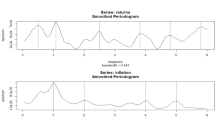Abstract
Most of the time series models discussed in the previous chapters are linear time series models. Although they remain at the forefront of academic and applied research, it has often been found that simple linear time series models usually leave certain aspects of economic and financial data unexplained. Since economic and financial systems are known to go through both structural and behavioral changes, it is reasonable to assume that different time series models may be required to explain the empirical data at different times. This chapter introduces some popular nonlinear time series models that have been found to be effective at modeling nonlinear behavior in economic and financial time series data.
Access this chapter
Tax calculation will be finalised at checkout
Purchases are for personal use only
Preview
Unable to display preview. Download preview PDF.
Similar content being viewed by others
18.7 References
Andersen, T., T. Bollerslev, F.X. Diebold and H. Ebens (2001). “The Distribution of Realized Stock Return Volatility,” Journal of Financial Economics, 61, 43–76.
Aguilar, O. and M. West (2000). “Bayesian Dynamic Factor Models and Portfolio Allocation,” Journal of Business and Economic Statistics, 18(3), 338–357.
Barnett, W.A., R.A. Gallant, M.J. Hinich, J.A. Jungeilges, D.T. Kaplan and M.J. Jensen (1997). “A Single-blind Controlled Competition Among Tests for Nonlinearity and Chaos,” Journal of Econometrics, 82, 157–192.
Brock, W.A., W.D. Dechert and J.A. Scheinkman (1987). “A Test for Independence Based on the Correlation Dimension,” unpublished manuscript, Department of Economics, University of Wisconsin, Madison.
Brock, W.A., W.D. Dechert, J.A. Scheinkman and B. LeBaron (1996). “A Test for Independence Based on the Correlation Dimension,” Econometric Reviews, 15, 197–235.
Brock, W.A., D.A. Hsieh and B. LeBaron (1991). Nonlinear Dynamics, Chaos, and Instability: Statistical Theory and Economic Evidence. MIT Press.
Brock, W.A. and S. Potter (1993). “Nonlinear Time Series and Macroeconomics,” in G.S. Maddala, C. R. Rao and H. D. Vinod (eds.), Handbook of Statistics, Vol. II. North-Holland, Amsterdam.
Caporale, G.M., C. Ntantamis, T. Pantelidis and N. Pittis (2004). “The BDS Test As a Test for the Adequacy of a GARCH(1,1) Specification: A Monte Carlo Study,” Working Paper, Brunel University.
Chauvet, M. (1998). “An Econometric Characterization of Business Cycle Dynamics with Factor Structure and Regime Switching,” International Economic Review, 39(4), 969–996.
Chauvet, M. and S. Potter (2000). “Coincident and Leading Indicators of the Stock Market,” Journal of Empirical Finance, 7, 87–111.
Davidson, R. and J. G. MacKinnon (1985). “Heteroskedasticity-Robust Tests in Regressions Directions,” Annales de l’INSEE, 59/60, 183–218.
de Lima, P.J.F. (1996). “Nuisance Parameter Free Properties of Correlation Integral Based Statistics,” Econometric Reviews, 15, 237–259.
Fernandes, M. and P.-Y. Preumont (2002). “The Finite-Sample Size of the BDS Test for GARCH Standardized Residuals,” unpublished manuscript, Department of Economics, Queen Mary, University of London.
Franses, P.H. and D. van Dijk (2000). Non-Linear Time Series Models in Empirical Finance. Cambridge University Press, Cambridge.
Granger, C.W.J. and T. Teräsvirta (1993). Modelling Nonlinear Economic Relationships. Oxford University Press, Oxford.
Hamilton, J.D. 1989. “A New Approach to the Economic Analysis of Nonstationary Time Series Subject to Changes in Regime,” Econometrica, 57, 357–384.
Hamilton, J.D. (1994). Time Series Analysis. Princeton University Press, Princeton.
Hansen, B.E. (1996). “Inference When a Nuisance Parameter is Not Identified Under the Null Hypothesis,” Econometrica, 64, 413–430.
Hansen, B.E. (1997). “Inference in TAR Models,” Studies in Nonlinear Dynamics and Econometrics, 2, 1–14.
Hansen, B.E. (1999). “Testing for Linearity,” Journal of Economic Surveys, 13(5), 551–576.
Kim, C.J. (1994). “Dynamic Linear Models with Markov-Switching,” Journal of Econometrics, 60, 1–22.
Kim, C.-J. and C.R. Nelson (1998). “Business Cycle Turning Points, a New Coincident Index, and Tests of Duration Dependence Based on a Dynamic Factor Model with Regime-Switching,” Review of Economics and Statistics, 80, 188–201.
Kim, C.-J. and C.R. Nelson (1999). State-Space Models with Regime-Switching: Classical and Gibbs-Sampling Approaches with Applications. MIT Press, Cambridge, MA.
Kim, M.-J. and J.-S. Yoo (1995). “New Index of Coincident Indicators: A Multivariate Markov Switching Factor Model Approach,” Journal of Monetary Economics, 36, 607–630.
Kim, S., N. Shephard and S. Chib (1998). “Stochastic Volatility: Likelihood Inference and Comparison with ARCH Models,” Review of Economic Studies, 65, 361–393.
LeBaron, B. (1997). “A Fast Algorithm for the BDS Statistic,” Studies in Nonlinear Dynamics and Econometrics, 2, 53–59.
Lundbergh, S. and T. Teräsvirta (1998). “Modelling Economic High-Frequency Time Series with STAR-GARCH Models,” Working Paper Series in Economics and Finance No. 291, Stockholm School of Economics.
Lundbergh, S. and T. Teräsvirta (2002). “Forecasting with Smooth Transition Autoregressive Models,” in M. P. Clements and D. F. Hendry (eds.), A Companion to Economic Forecasting. Blackwell Publishers, London.
Luukkonen, R, P. Saikkonen and T. Teräsvirta (1988). “Testing Linearity Against Smooth Transition Autoregressive Models,” Biometrika 75, 491–499.
Nelson, C.R. and C.I. Plosser (1982). “Trends and Random Walks in Macroeconomic Time Series: Some Evidence and Implications,” Journal of Monetary Economics, 10, 139–162.
Teräsvirta, T. (1994). “Specification, Estimation, and Evaluation of Smooth Transition Autoregressive Models,” Journal of the American Statistical Association, 89, 208–218.
Stock, J.H. and M.W. Watson (1991). “A Probability Model of the Coincident Economic Indicators,” in K. Lahiri and G.H. Moore (eds.), Leading Economic Indicators: New Approaches and Forecasting Records. Cambridge University Press, Cambridge.
Tong, H. (1978). “On a Threshold Model,” in C.H. Chen (ed.), Pattern Recognition and Signal Processing. Sijhoff & Noordhoff, Amsterdam.
Tong, H. (1990). Non-Linear Time Series: A Dynamical System Approach. Oxford University Press, Oxford.
Tsay, R.S. (1989). “Testing and Modeling Threshold Autoregressive Processes,” Journal of the American Statistical Association, 84(405), 231–240.
van Dijk, D., T. Teräsvirta and P.H. Franses (2002). “Smooth Transition Autoregressive Models–A Survey of Recent Developments,” Econometric Reviews, 21(1), 1–47.
Rights and permissions
Copyright information
© 2006 Springer Science+Business Media, Inc.
About this chapter
Cite this chapter
(2006). Nonlinear Time Series Models. In: Modeling Financial Time Series with S-PLUS®. Springer, New York, NY. https://doi.org/10.1007/978-0-387-32348-0_18
Download citation
DOI: https://doi.org/10.1007/978-0-387-32348-0_18
Publisher Name: Springer, New York, NY
Print ISBN: 978-0-387-27965-7
Online ISBN: 978-0-387-32348-0
eBook Packages: Mathematics and StatisticsMathematics and Statistics (R0)




